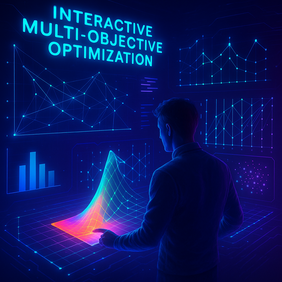Interactive Multi-Objective Optimization (iMOO)
16.05.2025Explore complex design spaces through interactive visualization—where data meets intuition. Join the iMOO project and shape the future of multi-objective optimization interfaces. We can fit the project to the requirements of a Game Research Lab, Bachelor or Master thesis.
Background
Designing next-generation electronic systems—such as lightweight, high-performance components for electric vehicles—requires solving multi-objective optimization (MOO) problems with a large number of competing criteria. The complexity of these tasks often obscures design trade-offs and impedes user interaction. This project seeks to address these challenges by developing an interactive optimization interface, in which users actively explore and guide the optimization process within a rich visual and interactive environment.
Tasks
Your mission is to create an interactive system that supports and visualizes multi-objective optimization (MOO) tasks, using a high-dimensional solver (e.g., NSGA-II) as its computational core.
Tasks include:
-
Develop a visual interface to explore and navigate complex design spaces (>10 dimensions)
-
Implement dimensionality reduction and dependency visualizations to highlight trade-offs
-
Design intuitive user interaction: selection of solutions, backtracking via history, comparative analytics
-
Integrate the interface with a machine-learning-enhanced MOO solver (provided)
-
Propose and document a sound scientific validation plan for assessing usability and performance
This project offers opportunities to dive into optimization algorithms, human-centered interface design, and interactive visualization—all within a relevant, applied engineering context.
Literature
[1] K. Deb, A. Pratap, S. Agarwal, T. Meyarivan. "A Fast and Elitist Multiobjective Genetic Algorithm: NSGA-II", IEEE Trans. on Evolutionary Computation, 2002.
[2] Moure et al. "Illuminating Search Spaces by Mapping Elites", 2015.
[3] Additional resources on dimensionality reduction, interactive design tools, and optimization visualization will be provided.
Supervision
Prof. Dr. Sebastian von Mammen
Prof. Dr. Jan Hansen
Institute of Electronics, Graz University of Technology







